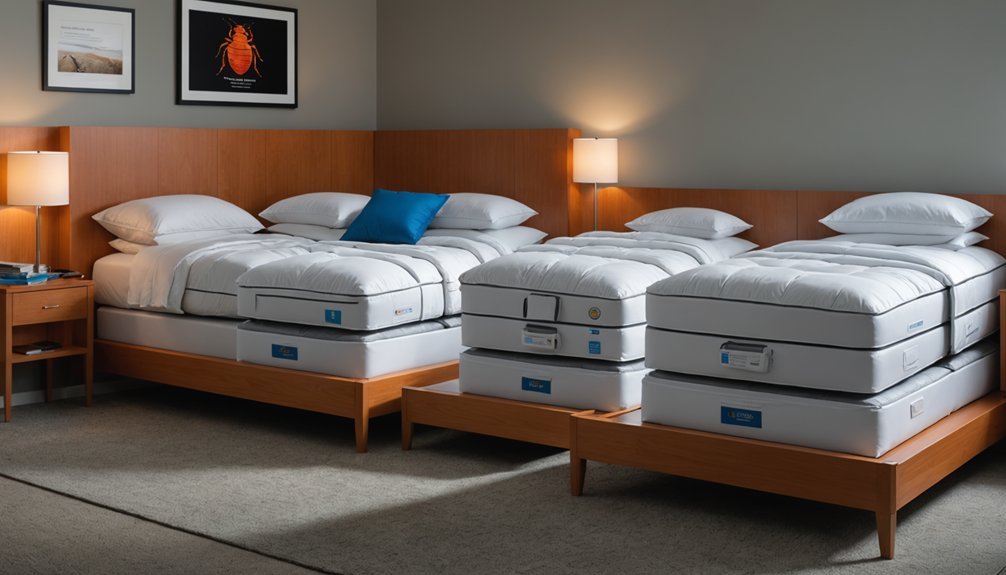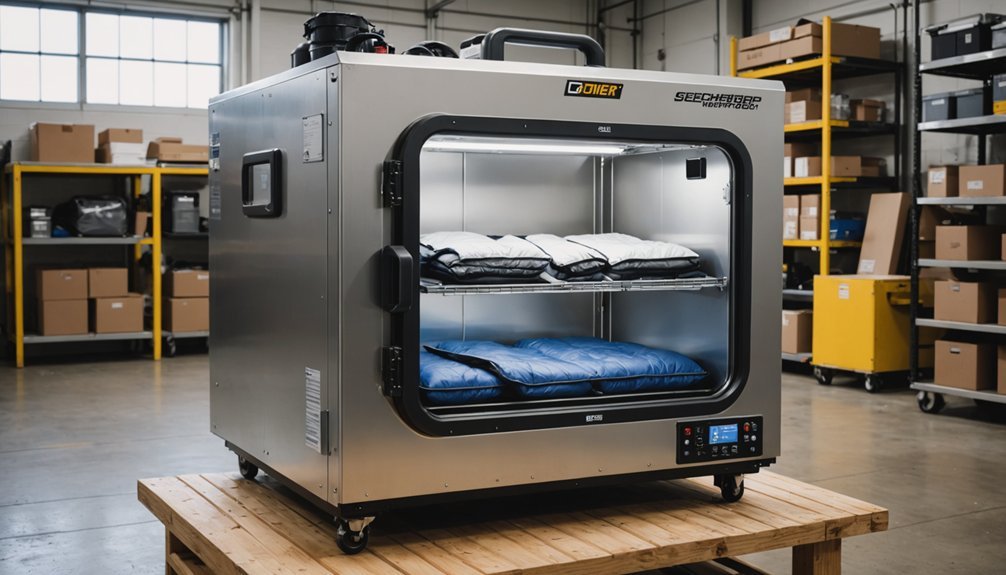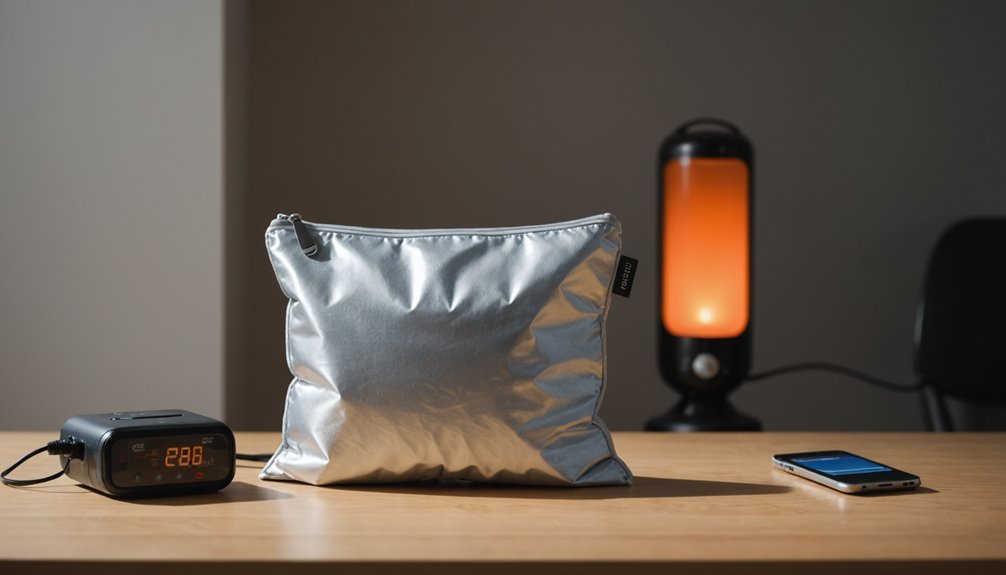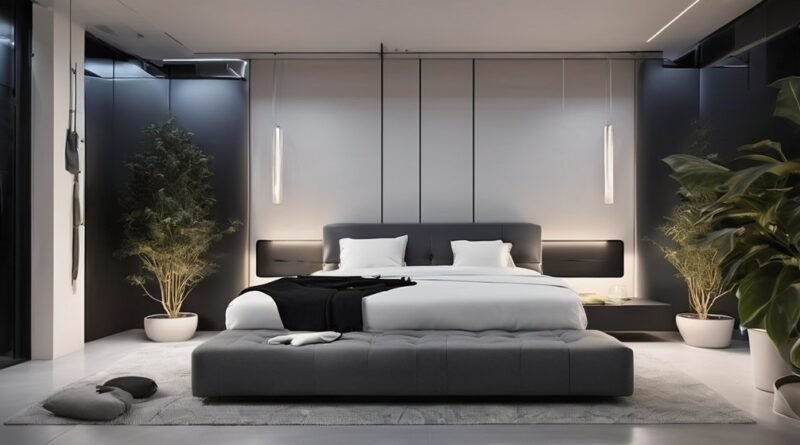Best Heat Chambers & Bags for Bed Bug Treatment
You’ve likely heard that heat treatment is one of the most effective ways to eliminate bed bugs, but choosing the right equipment makes all the difference. Whether you’re considering a portable heat bag or professional chamber system, you’ll need specific temperature ranges and airflow patterns for success. Understanding the essential features that separate premium units from ineffective ones will help protect your investment and guarantee complete eradication.
Key Takeaways
- Professional heat chambers should maintain 120-125°F for 20-30 minutes with multiple thermometers and PID controllers for optimal bed bug elimination.
- Electric heaters are preferred for indoor treatment spaces under 200 sq. ft., while BBHD8 models work best for 200-350 sq. ft. areas.
- Quality heat treatment bags should include insulation, temperature monitoring displays, and proper airflow distribution features for effective heat penetration.
- Heat chambers need strategically placed diffusers and adjustable registers to ensure even heat distribution and prevent temperature stratification.
- Commercial-grade equipment costs between $1,200-$3,000 but offers better reliability and fewer retreatments compared to DIY solutions.
Understanding Heat Treatment Technology for Bed Bug Control

While bed bugs have plagued humans for centuries, modern heat treatment technology offers one of the most effective solutions for eliminating these persistent pests.
You’ll achieve success rates above 97% by exposing bed bugs to temperatures between 120-125°F for at least 20-30 minutes. This method works because bed bugs can’t develop resistance to heat, which causes irreversible physical and physiological damage.
The process combines two essential heat distribution methods: conduction through solid objects and convection via circulated hot air. This targeting of multiple pathways ensures protein denaturation occurs, destroying essential cellular functions.
You’ll need to maintain consistent temperatures above 113°F throughout the treatment area while keeping relative humidity between 20-30% for best results.
Modern systems use industrial-grade equipment and precise monitoring to guarantee thorough penetration into every crack and crevice where bed bugs hide.
Professional Heat Chamber Features and Benefits

Professional heat chambers incorporate precise temperature monitoring systems with external displays, letting you track and maintain the critical 120-145°F range needed for bed bug elimination.
You’ll find multiple strategically placed thermometers throughout the chamber, ensuring accurate readings across the entire treatment space.
The combination of box fans and oscillating fans creates thorough airflow patterns that eliminate cold spots and distribute heat evenly through your items. This chemical-free solution effectively penetrates deep into furniture and cracks where pesticides often fail to reach.
Temperature Control Systems
Modern heat chambers rely on sophisticated temperature control systems that transform them from simple heated boxes into precision bed bug elimination tools. You’ll find integrated sensors like thermocouples and RTDs that feed real-time data to microprocessor-based controllers. These controllers use PID algorithms to maintain exact temperatures through power modulation of the heating elements. Proper validation testing protocols help verify chamber performance under different operating conditions.
| Component | Function | Key Benefit |
|---|---|---|
| Temperature Sensors | Monitor chamber heat | Guarantees lethal temps |
| PID Controllers | Regulate heating elements | Maintains stability |
| Heating Elements | Generate required heat | Provides killing power |
| Insulation | Retains chamber heat | Improves efficiency |
| Safety Systems | Prevent overheating | Protects contents |
The combination of precise sensing, intelligent control, and safety features guarantees your heat chamber delivers consistent, reliable bed bug elimination while protecting treated items from damage.
Airflow Distribution Features
Effective airflow distribution stands at the heart of any successful heat chamber design.
You’ll find the most efficient systems employ crossflow or one-way airflow patterns rather than circular configurations, as they provide deeper heat penetration and longer throw distances essential for thorough bed bug elimination. Optimal convective heat transfer occurs when air movement is properly controlled across treatment surfaces.
Your chamber should include strategically placed diffusers and adjustable registers to guarantee even heat distribution.
Look for models featuring slot diffusers with inactive sections, which help control airflow velocity and prevent hot spots.
The best systems also incorporate well-positioned grilles and dampers to maintain consistent air circulation and temperature balance throughout the treatment area.
When evaluating options, pay attention to the air volume per outlet – lower volumes through multiple smaller outlets typically deliver better heat penetration without creating disruptive air jets.
Portable Heat Bags vs. Professional Heat Chambers

When choosing between portable heat bags and professional heat chambers for bed bug treatment, you’ll need to weigh several key differences in effectiveness, convenience, and cost.
Portable heat bags take 6-8 hours for complete bed bug elimination but offer affordability and easy operation for treating personal items like clothing and bedding. Temperature monitoring shows that bags reach core temperatures of 50°C for reliable treatment results. You can use them repeatedly without professional help, making them ideal for travelers and apartment dwellers.
Portable heat bags provide a budget-friendly, DIY solution for treating bed bug-infested items, perfect for those seeking self-managed pest control.
Professional heat chambers work faster, typically killing bed bugs within hours by reaching temperatures above 120°F. They’re more thorough, treating entire rooms and penetrating deep into furniture and structural cracks.
While they require trained technicians and higher upfront costs, they’re often worth the investment for severe infestations or multi-unit buildings where complete eradication is essential.
Key Components of Effective Heat Treatment Systems
When you’re setting up a heat treatment system, proper temperature control is essential for reaching and maintaining the lethal 125°F to 135°F needed to kill bed bugs and their eggs.
You’ll need integrated thermostats and multiple heat elements that can be controlled individually to guarantee consistent temperatures throughout the treatment area.
Multiple fans and strategic air circulation components work together with your heating system to eliminate cold spots and push heated air into every crack and crevice where bed bugs might hide.
Temperature Control Systems
To successfully eliminate bed bugs through heat treatment, sophisticated temperature control systems serve as the backbone of modern eradication equipment.
You’ll find integrated thermostats that maintain lethal temperatures between 50°C and 60°C automatically, while wireless sensors enable remote monitoring for safer, more efficient treatments.
- Multi-sensor arrays track temperatures across multiple locations simultaneously, ensuring thorough coverage
- Data logging capabilities record temperature profiles to verify treatment effectiveness
- Wireless monitoring systems alert you if doors or windows compromise the treatment
- Remote power consumption tracking helps detect equipment issues before treatment fails
- Integrated controls automatically adjust heating elements to maintain ideal temperature distribution
These advanced control features let you conduct professional-grade heat treatments with precision and confidence, while minimizing the need for constant manual supervision.
Heat Distribution Components
Successful bed bug heat treatments rely on five essential component groups working together: heat sources, air circulation, insulation, monitoring equipment, and power distribution.
Your heat distribution setup must include properly positioned heaters and fans to create consistent lethal temperatures throughout the treatment area. You’ll need multiple heaters rated between 9-20 kW, with electric units preferred for indoor use and propane systems for outdoor operation.
| Component | Function |
|---|---|
| Box Fans | Even air circulation |
| Oscillating Fans | Cold spot prevention |
| Electric Heaters | Safe indoor heating |
| Propane Systems | Rapid temp increase |
Place at least two box fans and one oscillating fan per room to maintain positive air pressure and guarantee thorough heat penetration into cracks and furniture. This circulation prevents temperature stratification and creates uniform heat exposure needed for effective treatment.
Safety Measures and Operating Guidelines
Before operating any heat treatment equipment for bed bug control, you’ll need to understand essential safety protocols and guidelines. Proper safety measures protect both you and your property while guaranteeing treatment effectiveness.
- Remove heat-sensitive items like aerosols, cosmetics, medications, and electronics before treatment, placing them in labeled “Do Not Heat” containers near the entrance.
- Keep pets, plants, and people out of the treatment area and change aquarium water after completion to prevent heat stress.
- Use only professional-grade heating equipment designed specifically for bed bug treatment to avoid fire hazards.
- Maintain proper ventilation and monitor temperatures continuously throughout the 6-8 hour treatment period.
- Leave doors, drawers, and closets open to guarantee heat penetrates all spaces and reaches the lethal temperature of 118°F for effective bed bug elimination.
Maximizing Treatment Success With Proper Equipment Selection
When selecting bed bug heat treatment equipment, matching the right size and power capacity to your specific needs determines success or failure. You’ll need to take into account room dimensions, power availability, and heat distribution requirements. For spaces under 200 sq. ft, a DIY 110V heater works well, while larger areas demand commercial units with higher BTU ratings.
| Room Size | Recommended Equipment | Power Requirements |
|---|---|---|
| <200 sq ft | DIY 110V Heater | Single 110V outlet |
| 200-350 sq ft | BBHD8 Model | 220/240V + two 110V |
| >350 sq ft | Multiple Heaters | Multiple circuits |
| Vehicles/Small | Portable Unit | Standard 110V |
Don’t forget to factor in airflow management – you’ll want systems with quality convection fans or separate air movers to guarantee uniform heat distribution and temperature maintenance throughout the treatment area.
Cost Analysis and Return on Investment
Understanding the financial aspects of bed bug heat treatments helps determine whether to purchase equipment or hire professionals.
Initial costs for heat treatment systems range from $1,200 to $3,000 for residential use, while professional services vary based on property size and infestation severity.
- Standard one-bedroom treatments cost $300-$650, while whole-house treatments can reach $5,000.
- Commercial-grade equipment requires higher upfront investment but offers better long-term reliability.
- Heat treatments typically need fewer retreatments compared to chemical alternatives, reducing overall costs.
- DIY solutions cost less initially but may lead to higher expenses if treatments aren’t fully effective.
- Professional-grade systems often pay for themselves through reduced retreatment needs and higher success rates.
You’ll find the best ROI by choosing quality equipment that matches your treatment area size and frequency needs.
Conclusion
You’ll find that investing in quality heat treatment equipment pays off through reliable bed bug elimination and reduced retreatment needs. Whether you choose a professional chamber or portable heat bag, guarantee it maintains consistent temperatures and proper airflow distribution. Remember to follow safety protocols and operating guidelines carefully. With the right equipment and proper technique, you’ll achieve successful bed bug elimination every time.

